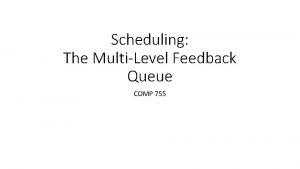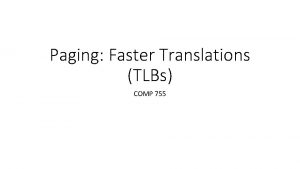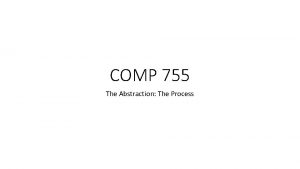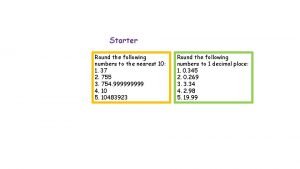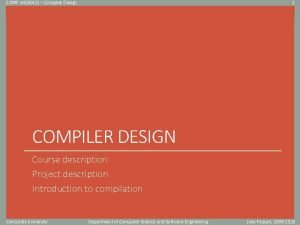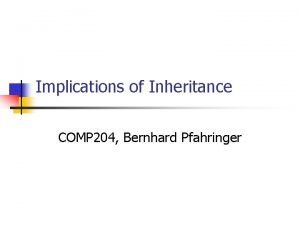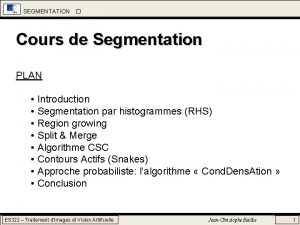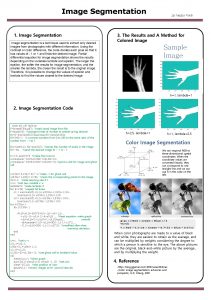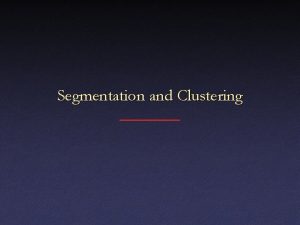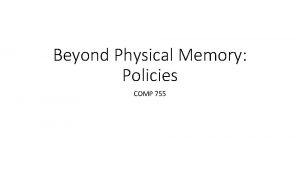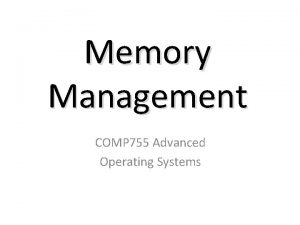Segmentation COMP 755 How to address large address


















- Slides: 18

Segmentation COMP 755

How to address large address space? • A 32 -bit address space (4 GB in size); a typical program will only use megabytes of memory, but still would demand that the entire address space be resident in memory. This just a waste of space. • To solve this problem, an idea was born, and it is called segmentation.

Segmentation: Generalized Base/Bounds • Instead of having just one base and bounds pair in our MMU, why not have a base and bounds pair per logical segment of the address space? • We have three logically-different segments: code, stack, and heap. What this allows the OS to do is to place each one of those segments in different parts of physical memory, and thus avoid filling physical memory with unused virtual address space.

Base and Bounds • For example, see Figure 16. 2 (page 3); there you see a 64 KB physical memory with those three segments in it (and 16 KB reserved for the OS). • So the hardware structure for out MMU would be:

Example Translation • Assume a reference is made to virtual address 100 (which is in the code segment). When the reference takes place (say, on an instruction fetch), the hardware will add the base value to the offset into this segment (100 in this case) to arrive at the desired physical address: 100 + 32 KB, or 32868. • It will then check that the address is within bounds (100 is less than 2 KB), find that it is, and issue the reference to physical memory address 32868.

SEGMENTATION FAULT The term segmentation fault or violation arises from a memory access on a segmented machine to an illegal address. Humorously, the term persists, even on machines with no support for segmentation at all. Or not so humorously, if you can’t figure why your code keeps faulting. int array[10]; … array[10] = 100; // Segmentation fault!

Address in heap example • Suppose we attempt to access the virtual address 4200. If we just add the virtual address 4200 to the base of the heap (34 KB), we get a physical address of 39016, which is not the correct physical address. • Need to first do is extract the offset into the heap, i. e. , which byte(s) in this segment the address refers to. Because the heap starts at virtual address 4 KB (4096), the offset of 4200 is actually 4200 minus 4096, or 104. • We then take this offset (104) and add it to the base register physical address (34 K) to get the desired result: 34920.

Which Segment Are We Referring To? • The hardware uses segment registers during translation. • How does it know the offset into a segment, and to which segment an address refers? • One way to do this is by using the explicit approach. • In our example, then, if the top two bits are 00, the hardware knows the virtual address is in the code segment, and thus uses the code base and bounds pair to relocate the address to the correct physical location. If the top two bits are 01, the hardware knows the address is in the heap, and thus uses the heap base and bounds.

Heap example again. • The virtual address from above (4200) and translate it, just to make sure this is clear. The virtual address 4200, in binary form, can be seen here: As you can see from the picture, the top two bits (01) tell the hardware which segment we are referring to. The bottom 12 bits are the offset into the segment: 0000 0110 1000, or hex 0 x 068, or 104 in decimal.

Implicit approach • In the implicit approach, the hardware determines the segment by noticing how the address was formed. • For example, suppose the address was generated from the program counter (i. e. , it was an instruction fetch), then the address is within the code segment; if the address is based off of the stack or base pointer, it must be in the stack segment; any other address must be in the heap.

Stack • The stack has been relocated to physical address 28 KB in the diagram above, but with one critical difference: it grows backwards. In physical memory, it starts at 28 KB and grows back to 26 KB, corresponding to virtual addresses 16 KB to 14 KB; translation must proceed differently. • The first thing we need is a little extra hardware support. Instead of just base and bounds values, the hardware also needs to know which way the segment grows (a bit, for example, that is set to 1 when the segment grows in the positive direction, and 0 for negative).

Stack virtual address • Given virtual address 15 KB, which should map to physical address 27 KB. Or virtual in binaryform, like this: 11 1100 0000 (hex 0 x 3 C 00). • The hardware uses the top two bits (11) to designate the segment, but then we are left with an offset of 3 KB. • To obtain the correct negative offset, we must subtract the maximum segment size from 3 KB: 3 KB-4 KB = -1 KB. • Add the negative offset (-1 KB) to the base. 28 KB – 1 KB = 27 KB • The bounds check can be calculated by ensuring the absolute value of the negative offset is less than the segment’s size.

Support for Sharing • As support for segmentation grew, system designers soon realized that they could realize new types of efficiencies with a little more hardware support. Specifically, to save memory, sometimes it is useful to share certain memory segments between address spaces. In particular, code sharing is common and still in use in systems today.

Protection bits • The hardware, in the form of protection bits, provides basic support by adding extra few bits per segment. • Indicating whether or not a program can read or write a segment, or perhaps execute code that lies within the segment.

OS Support: two issues • The first issue is what should the OS do on a context switch? The segment registers must be saved and restored. Each process has its own virtual address space, and the OS must make sure to set up these registers correctly before letting the process run again. • The second, and more important, issue is managing free space in physical memory. When a new address space is created, the OS has to be able to find space in physical memory for its segments.

Memory Allocation • The general problem that arises is that physical memory quickly becomes full of little holes of free space, making it difficult to allocate new segments, or to grow existing ones. We call this problem external fragmentation; see Figure 16. 6 (left). • Compaction is expensive, as copying segments is memory-intensive and generally uses a fair amount of processor time. (Poor)

Summary • Segmentation solves a number of problems, and helps us build a more effective virtualization of memory. Beyond just dynamic relocation, segmentation can better support sparse address spaces, by avoiding the huge potential waste of memory between logical segments of the address space. • It is also fast, as doing the arithmetic segmentation requires is easy and well-suited to hardware; the overheads of translation are minimal. • A fringe benefit arises too: code sharing.

Summary Continued • Allocating variable-sized segments in memory leads to some problems. • External fragmentation • Segmentation still isn’t flexible enough to support our fully generalized, sparse address space.
 Multilevel feedback queue
Multilevel feedback queue Segmentation
Segmentation Comp 755
Comp 755 Vpn12vpn.buzz
Vpn12vpn.buzz Comp 755
Comp 755 Comp 755
Comp 755 190 755 799
190 755 799 Round 442 to the nearest ten
Round 442 to the nearest ten Through market segmentation companies divide large
Through market segmentation companies divide large Combined segmentation and paging
Combined segmentation and paging Our cosmic adress
Our cosmic adress Logical memory vs physical memory
Logical memory vs physical memory Comp4462
Comp4462 Kidbiz 300
Kidbiz 300 Comp 442
Comp 442 Comp 204
Comp 204 Comp 3000
Comp 3000 Robozzle solutions
Robozzle solutions Comp set hotel
Comp set hotel
